Authentic German Springerle Cookies
This post may contain affiliate links. See my disclosure policy.
Springerle are German anise-flavored cookies that go back at least 700 years in their rich tradition as special gifts during the holidays and other celebrations. Delicately crispy-crunchy and a slightly chewy center, they’re made with simple ingredients and are easy to make but absolutely require that you follow some key steps to achieving the right look, texture and flavor. This authentic Springerle cookies recipe goes back to the Swabia region of Germany where these famous cookies originated.
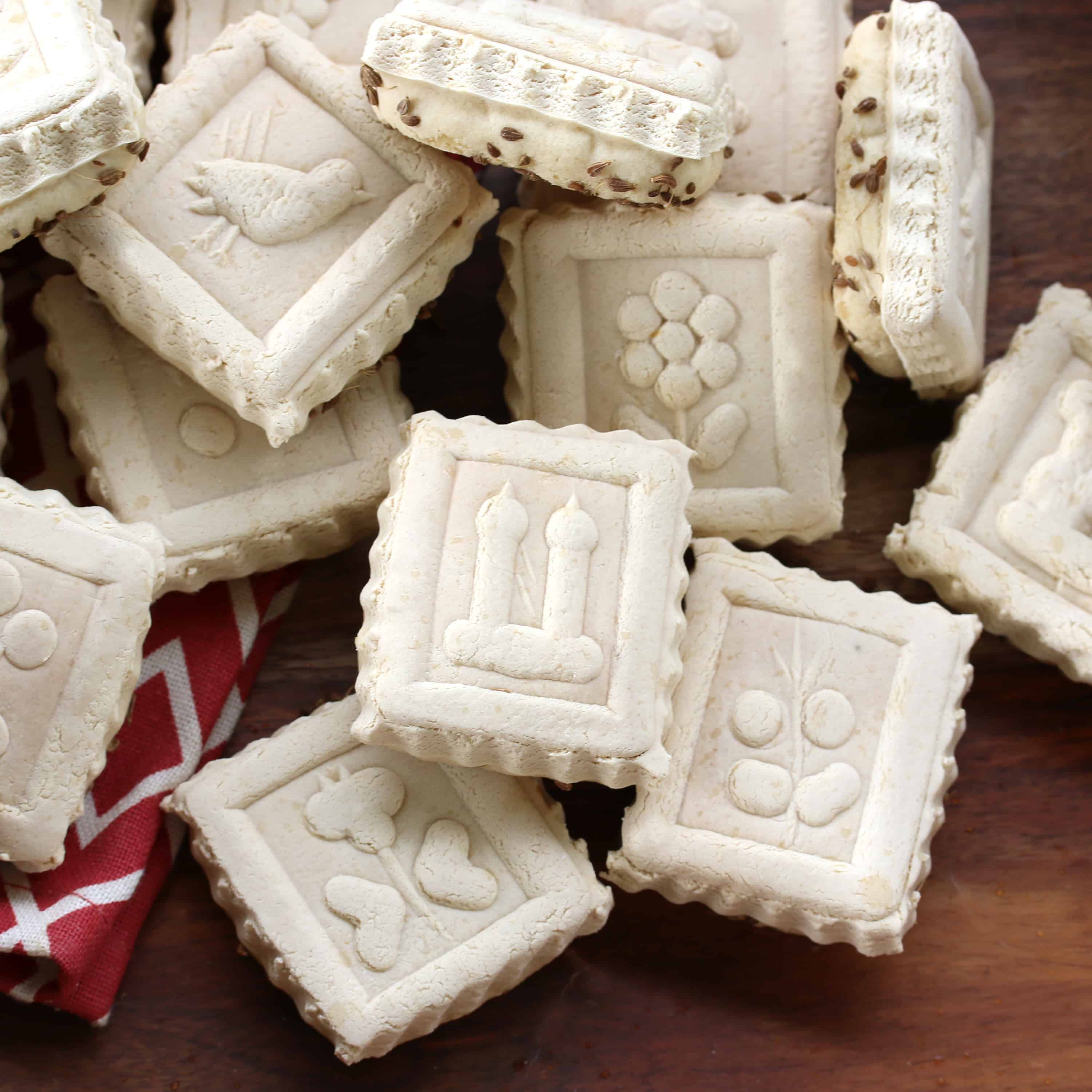
What Are Springlere Cookies?
Springerle are traditional German cookies with a very long, very rich history and tradition and come from the Swabia region of southern Germany where I’m from. They’re delicately flavored with anise and are embossed with a variety of designs. Historically made for religious holidays and other special occasions, today they are most commonly made during the Christmas season and for New Year’s though Springerle with flowers, landscapes and other everyday designs remain popular throughout the year. The name “Springerle” translates from German as “little jumpers” because of their behavior of rising or “jumping up” while they’re baking.
Authentic Springerle are made with eggs, sugar, flour, baker’s ammonia, salt and anise. They’re a very low-moisture cookie that are made without any fat. Springerle are very hard cookies that are stored long-term to undergo a period of “ripening” for several weeks as their flavor and texture develops. Over time they develop a delicately crispy-crunchy, shattering exterior and a slightly chewy center. They are traditionally eaten with and dunked in a hot beverage.
The hallmark of Springerle lies in the beauty of their presentation created by special molds used to emboss designs on their surface. Springerle were traditionally made as gifts, as charms for happiness, to give to friends and loved ones on special occasions such as births, weddings, betrothals, during the Christmas season and on New Year’s.
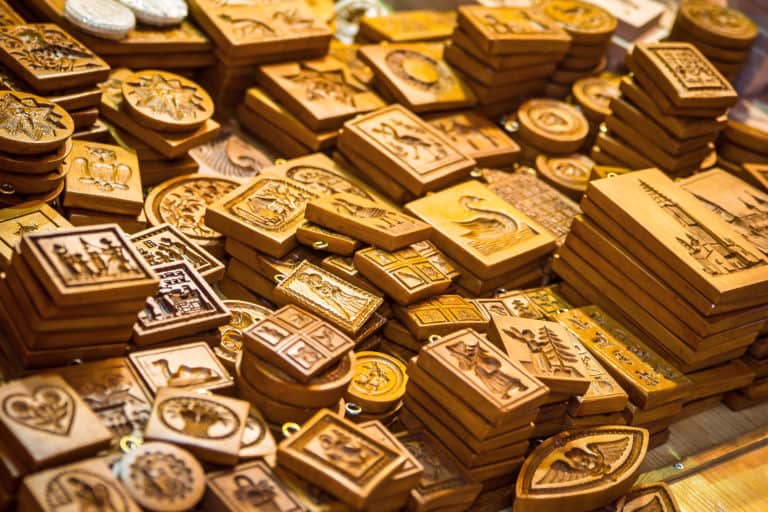
A Brief History of Springerle Cookies
These renowned cookies can be traced back to at least the 1300’s to the Swabia region of southern Germany where they were regarded as charms for good luck, happiness and religious observance. Historically Springerle molds were a German baker’s opportunity to show off his woodcarving skills. At that time baking apprentices in Swabia Germany not only had to demonstrate their ability to bake, they also had to carve their own Springerle molds as a kind of rite of passage to becoming a full-fledged, bona fide baker. The more intricate and detailed the mold, the more heralded the baker. These molds were passed down from generation to generation as treasured family heirlooms.
In fact, so prized were these family heirlooms that Germans immigrating to the United States in the 17th and 18th centuries would make space in their luggage just for their Springerle molds.
The themes of the Springerle molds changed throughout the centuries, transitioning from the earlier religious symbols in the 15th century to scenes of gallantry with knights on horseback, then on to the more romantic and highly detailed images of the 19th century with flowers, landscapes, and symbols of love, marriage and friendship. In the 20th century designs included things like Santa Claus, reindeer, and Christmas trees.
You can still buy both simple and elaborate wood-carved Springerle molds in Germany and you can also find antique ones that usually command a hefty price, especially the very detailed ones.
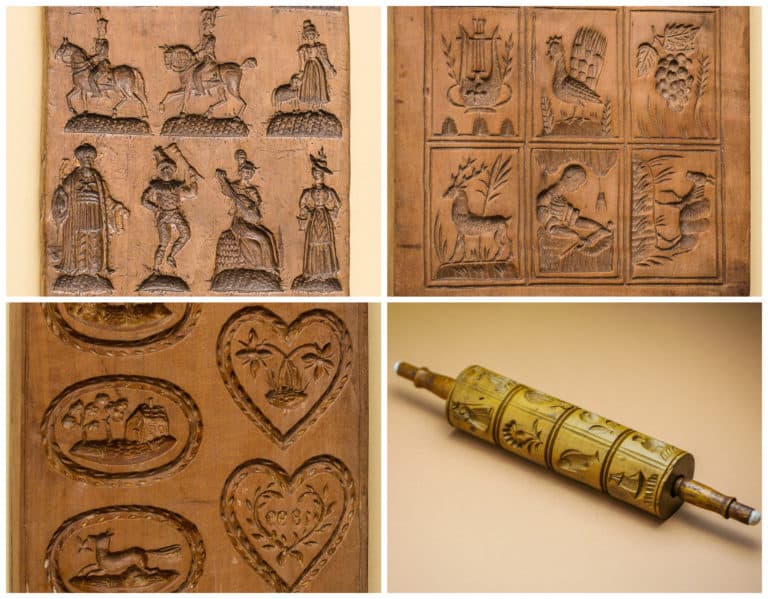
Special Equipment: Springerle Cookie Molds
Trying to find Springerle molds outside of Germany and other European countries that make cookies using molds (eg, Belgium and the Netherlands’ well-known speculoos/speculaas cookies), is very challenging. You can buy antique molds on eBay at a premium price or you can just use whatever you have that’s available. For example, you can use cookie stamps. There are a number of inexpensive ones on the market as well as high quality ones like these cookie stamps from Nordic Ware that are built to last and whose designs are cut deep enough to make a good impression on the cookie (Nordic Ware has multiple designs to choose from). I have three different sets of Nordic Ware cookie stamps.
Pictured below is my Springerle rolling pin that I brought with me from Stuttgart, Germany before I moved to the U.S.. This is the mold that I used in the pictures for this recipe. A Springerle rolling pin is easy to use and you can crank out a ton of Springerle very quickly. Amazon has a hand-carved Springerle rolling pin that looks similar to mine.
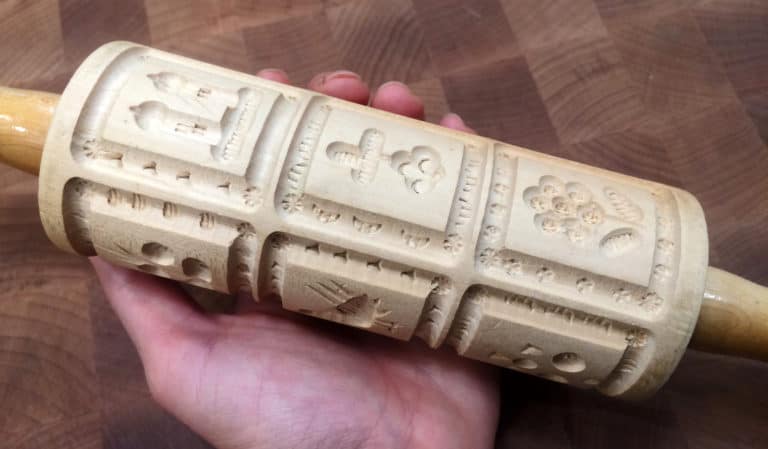
How to Make Authentic Springerle Cookies
I’m going to share 5 keys with you, 5 essential elements, for making authentic German Springerle.
Key #1 to Making Authentic Springerle: Baker’s Ammonia
Ammonium bicarbonate, known as baker’s ammonia, is an old-fashioned leavening agent that was commonly used until the 19th century when baking soda and baking powder came onto the scene. If you look through very old cookbooks you’ll find baker’s ammonia in the list of ingredients for specific kinds of baked goods. And while baking powder and baking soda largely replaced and perform a similar function to baker’s ammonia, they are not one and the same. In Europe and the Middle East, for example, some recipes for low-moisture things like crackers and crispy cookies still call for baker’s ammonia because of its unique qualities that baking powder or baking soda cannot replicate. It’s also used (either that or potash) for other types of “flat” baked goods such as German Lebkuchen, Honigkuchen and a German pastry known as Amerikaner, to “loosen” the texture of their crumb.
Springerle are the perfect example of a baked good that really requires the use of baker’s ammonia to get the right results and that’s traditionally what they were always made with.
It doesn’t matter which brand you use, but select one that’s food grade. I’ve been using organic food grade Baker’s Ammonia from Pure Organics.
*Just a note of warning: Baker’s ammonia smells BAD. Really bad. But don’t worry, the smell dissipates during baking.
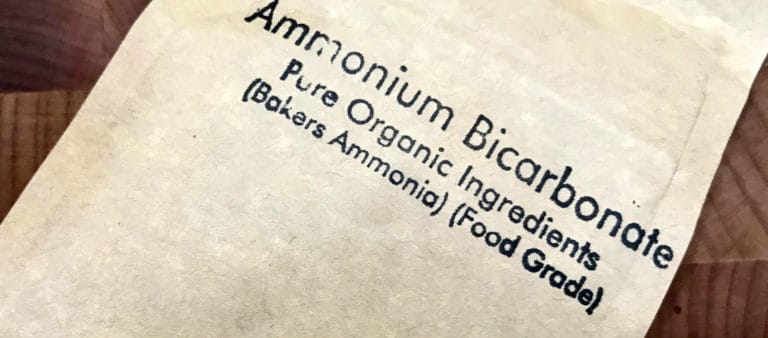
Baker’s Ammonia vs. Baking Powder vs. Baking Soda
Besides having different chemical compositions, they perform differently. While all three are leavening agents, baker’s ammonia creates an effect that baking powder and soda cannot replicate. As the cracker or cookie is baking, the tiny crystals in the ammonium bicarbonate break down and leave tiny air pockets behind in the crumb. The best way to describe the effect is that baker’s ammonia creates a unique honey-combed, porous crumb so that hard baked goods like crackers and cookies/biscuits have a more delicate, crispier, crunchier texture. Baker’s ammonia also contributes to a more even spread of the cookies.
Baker’s ammonia does have a very strong, very unpleasant odor but don’t be put off by that – the odor and taste will dissipate during baking.
In contrast what you normally get with a baked good that has virtually no moisture in it is something you could break your tooth on or could serve as a door stopper. (Think military hard tack from generations ago. Soldiers had to dip it in their coffee in order to make it edible.)
THAT is what you get if you make Springerle without baker’s ammonia: Rock hard, tooth-breaking, door-stopping cookies.
But let’s also be clear on something: Springerle are meant to be hard. And they’re traditionally eaten with a hot beverage for dipping. But the difference is that the baker’s ammonia creates that honey-combing effect that makes them less dense and gives them a more delicate and crunchy crumb.
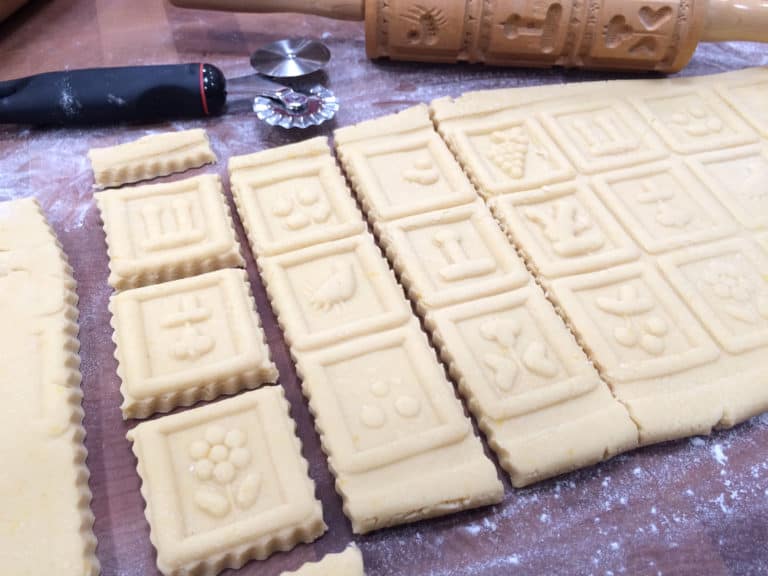
In addition to the texture advantage of using baker’s ammonia for low-moisture, crispy goods, it also doesn’t leave behind the characteristic soapy flavor that baking powder or soda does.
Cook’s Illustrated’s verdict: “[Baker’s ammonia] works so well, we’d be tempted to use it for crisp baked goods all the time if it were more readily available.” The good news is that it’s readily available online.
Key #2: Authentic Springerle DO NOT Use Butter or Fat of Any Kind. ZERO.
What about the fact that most of the recipes out there on the web don’t call for baker’s ammonia? How do they try to get around the hard-as-a-rock, tooth-breaking factor? They add butter. They add fat in their workaround to soften it up a bit. The result? Shortbread, not Springerle. Different flavor, different texture.
So use the butter to make Scottish Shortbread. But if you want Springerle leave the butter in the fridge. There is no place for butter in traditional Springerle.
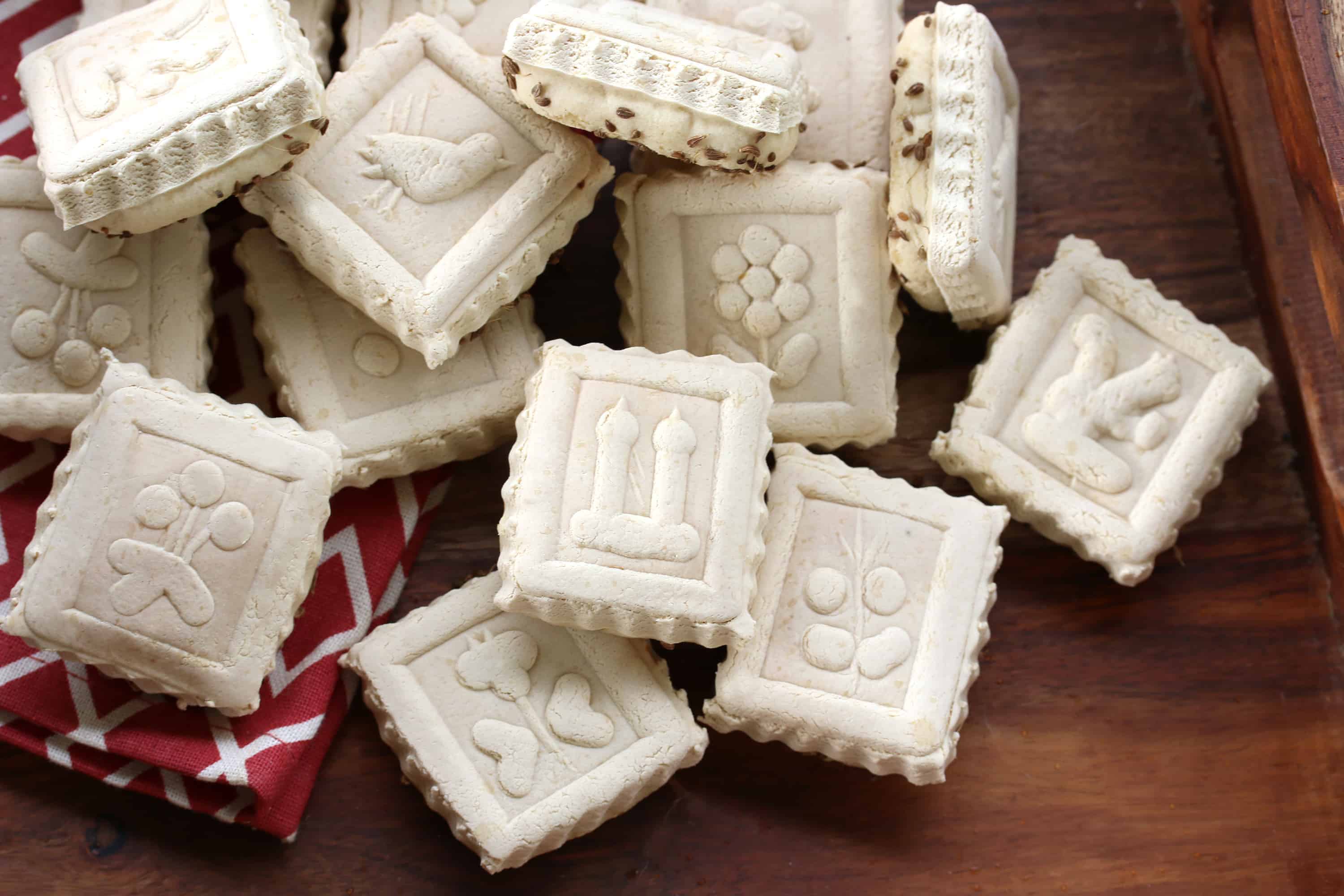
Next let’s talk about the flavor of traditional Springerle. Being made with nothing but eggs, flour and sugar they really have very little flavor. That’s where the anise comes in. There’s also the addition of the lemon zest which is optional but which we recommend because it contributes a lovely bright contrast and balance to the anise.
Key #3: Fresh Anise Seeds and Quality Pure Anise Oil
Traditionally whole anise seeds are always used. They’re dry roasted in a pan to release their oils and maximize flavor, then they’re strewn across the baking sheet before the Springerle are set on top of them. In addition to the anise seeds many German bakers will also add a few drops of pure anise oil for an added boost in flavor. We also recommend it.
The quality of your anise oil matters. It needs to taste real and it needs to be potent enough so that you only need to add a tiny bit of the oily liquid to achieve the flavor effect. So be sure to use quality 100% pure anise oil.
I use and recommend Lorann’s 100% Pure Anise Oil. It’s very potent and a few drops go a long way.
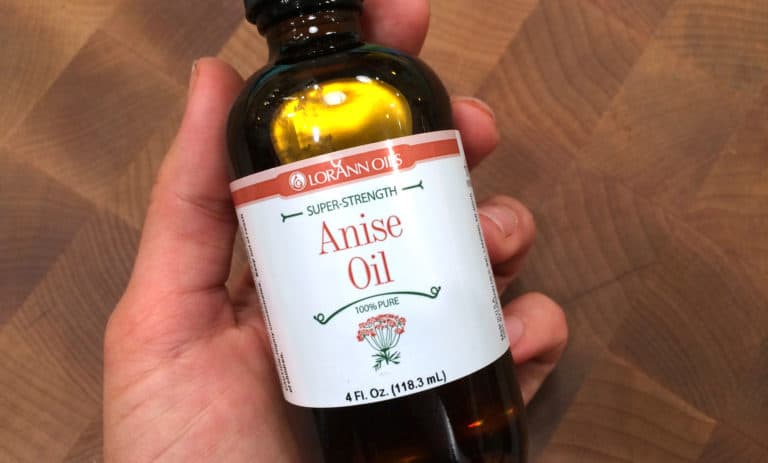
Key #4: Let the Springerle Air Dry For 24 Hours Before Baking Them
The whole purpose of Springerle are to be able to showcase their beautiful embossed designs and if you bake them right away the designs will not hold their shape or form.
In order for the embossed designs to stay in place during baking you need a dough that is super low-moisture to start and then the cookies need to be left to further dry out and develop a hardened crust on the exterior. This way the designs remain stable and unaltered during baking.
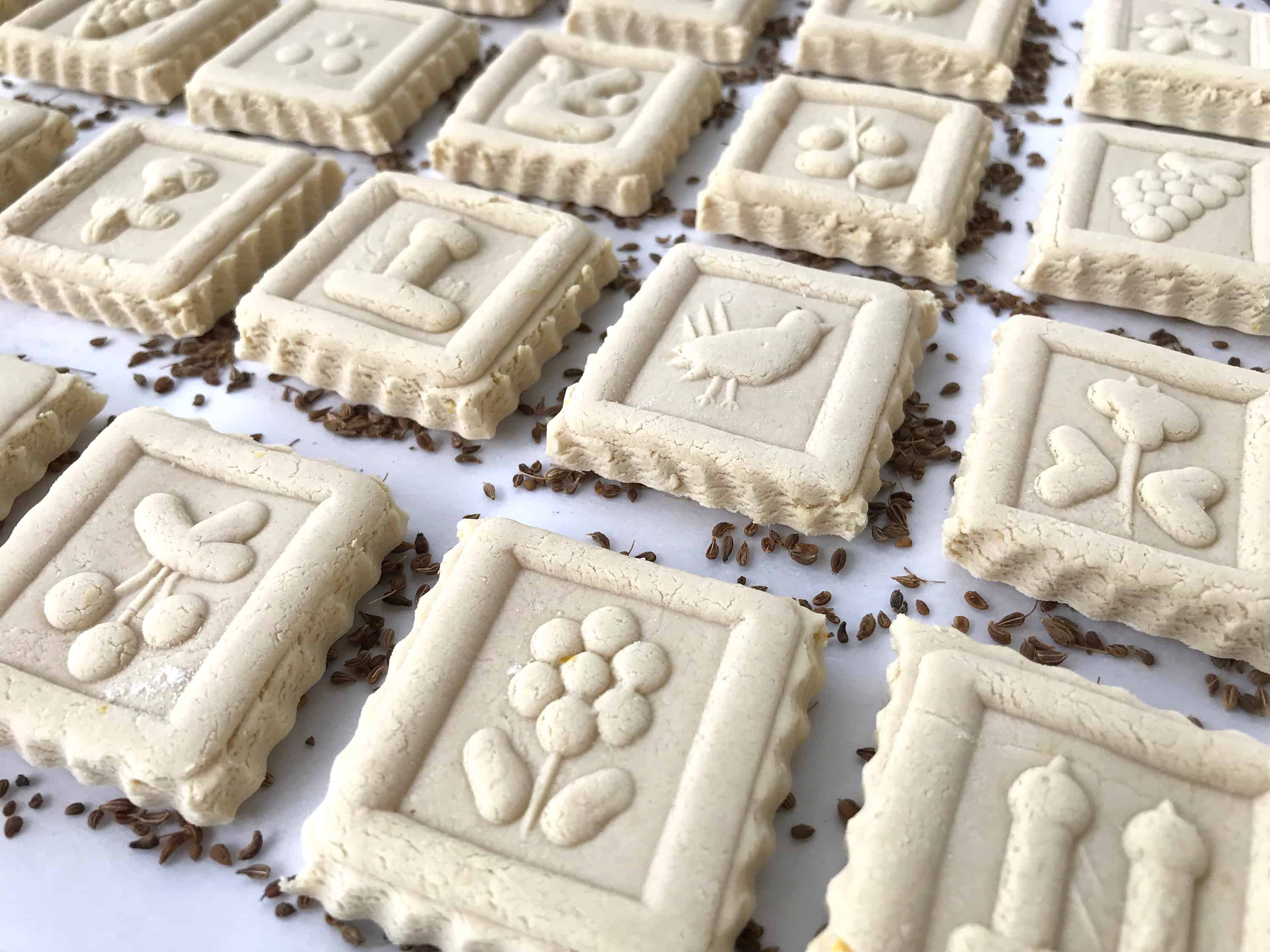
Key #5: Moisten the Bottom of Each Air-Dried Springerle Before Baking Them
The purpose of this step hearkens back to the meaning of their name, Springerle, which means “little jumpers.” Springerle rise in a particular way, creating their characteristic platform on the bottom or “feet” as they call it in Germany. In other words, they “spring up” on their “feet” while baking.
There is an important functional purpose for lightly moistening the bottom of the cookies. Once the cookies have dried for 24 hours they can have uneven moisture spots throughout. This can result in the Springerle rising more quickly on one side than the other, resulting in slanted or lop-sided cookies. To prevent that we lightly and evenly moisten the bottoms by gently pressing the cookie down on a damp cloth. That’s the key for enabling an even-leveled rise.
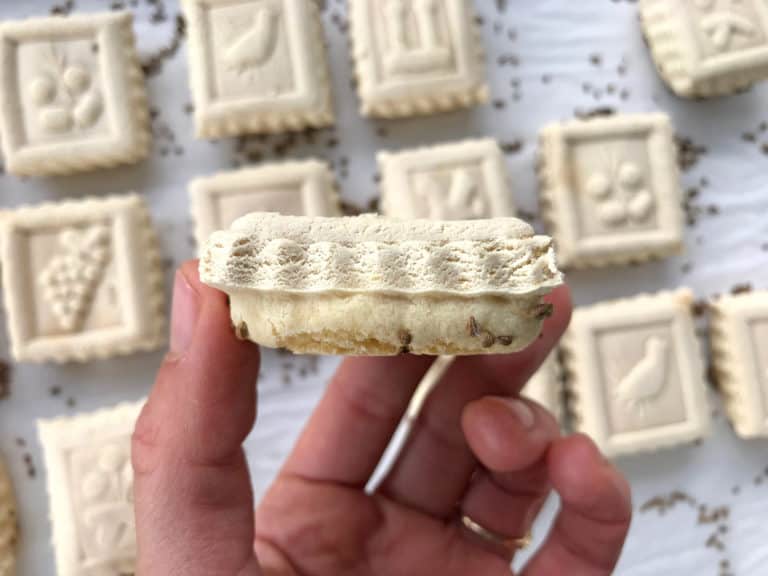
Authentic Springerle Cookies Recipe
Let’s get started!
Place the eggs in a stand mixer with the whisk attachment in place. Beat the eggs until foamy. Add the powdered sugar, a little at a time along with the vanilla sugar (or extract), anise oil and lemon zest (if using).
Once all the powdered sugar has been added continue to beat the mixture for 10 minutes. Yes, that’s 10 full minutes. The batter needs to be very loose and airy. Note: Follow the instructions on your stand mixer to give your machine a rest after the suggested amount of time so as not to overwork your mixer.
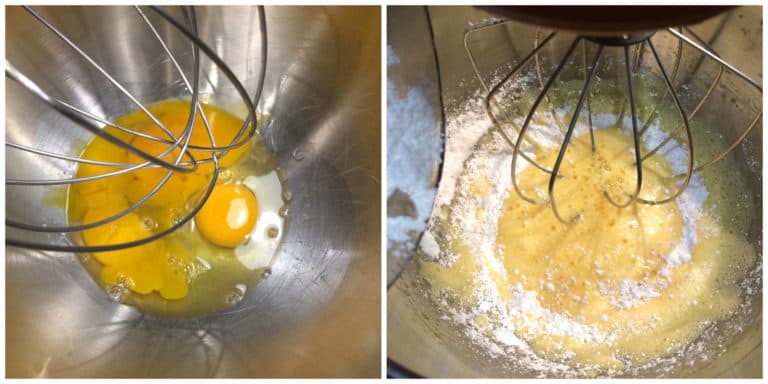
Combine the flour, baker’s ammonia and salt in a bowl. Add HALF of the flour mixture to the wet mixture along with the and beat it for a full 15 minutes.
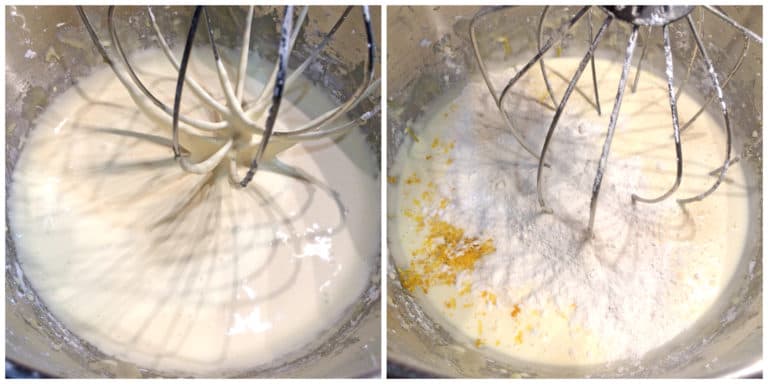
Attach the paddle attachment now. Add the remaining flour and beat for another 5 minutes.
The dough should be very soft but not wet and sticky.
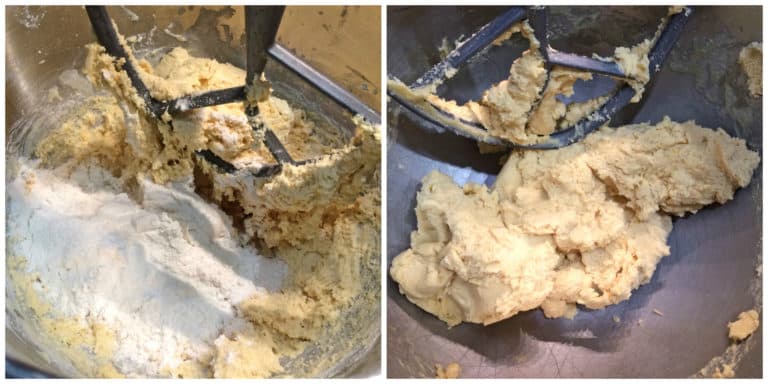
Form the dough into a ball, flatten it to an inch-thick disk, wrap it in plastic wrap and refrigerate for at least an hour or overnight.
The next day roll out the cold dough to about 1/3 inch thick (1 cm) on a floured work surface.
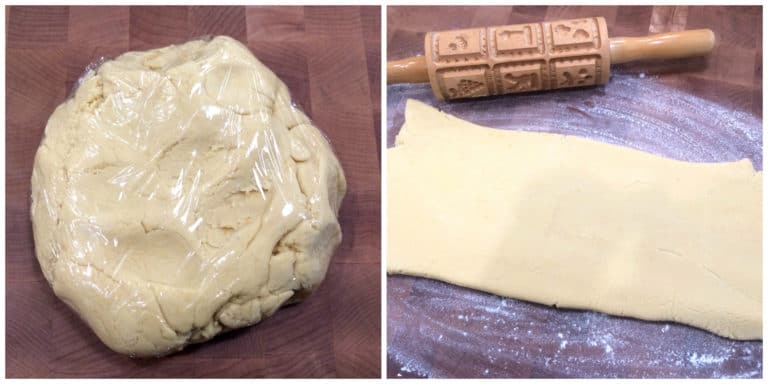
Use your molds or rolling pin to make the shapes and cut them out with sharp knife or pastry cutter. If you’re using molds lightly dust them with flour to prevent the dough from sticking.
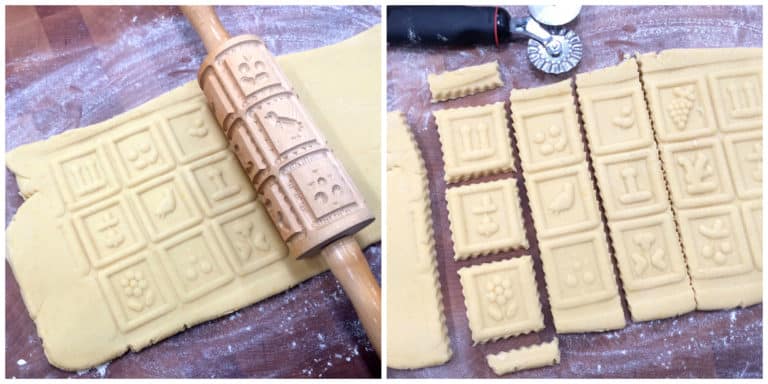
Toast the whole anise seeds in a dry pan over medium-high heat until aromatic, being careful not to let them scorch. Place the anise seeds on a lined cookie sheet, spreading them out evenly.

Lay the Springerle on top of the anise seeds on the baking sheet. Let them dry at room temperature for a full 24 hours, longer if you’re in a place with high humidity. The outside of the Springerle should be dry.
Lay a damp towel on the counter and gently press the Springerle down onto it to very lightly and evenly moisten the bottoms. Return the Springerle back to the cookie sheet.
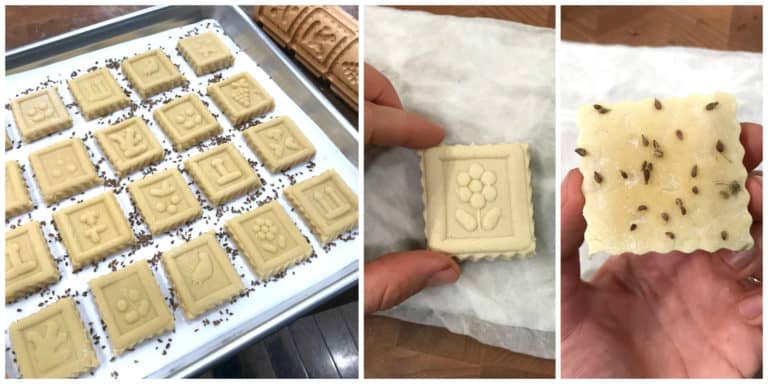
In an oven preheated to 300 degrees F with the rack positioned in the middle, bake the cookies for 20-30 minutes. Do not let the cookies turn golden, they’re supposed to stay very pale, basically the same color as when you put them in the oven.
The Springerle should have risen evenly to create their characteristic “feet” or platform underneath. Let the cookies cool off completely. They will become very hard as they cool.
Springerle are traditionally stored in airtight containers with half of an apple next to them inside the container to create a little bit of moisture to gradually soften the cookies over time. Periodically change out the apple. Once the Springerle have slightly softened up you can remove the apple and then continue storing them in the airtight container waiting for the flavor to develop.
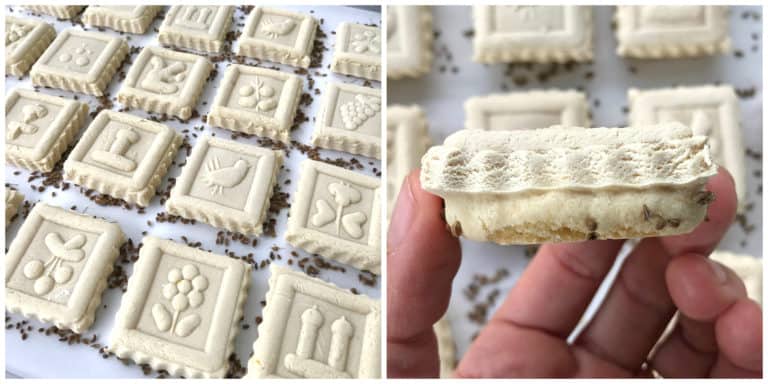
One of the nice things about Springerle is that they’re supposed to be made far in advance. So you can make them weeks before Christmas, set them aside and forget about them, and continue on with your other Christmas preparations.
Most Springerle bakers agree that waiting 3-4 weeks before eating them is best to allow the flavor and texture to develop.Enjoy these Springerle on their own or, as is tradition, enjoy them with a hot beverage and dip them.
Enjoy!
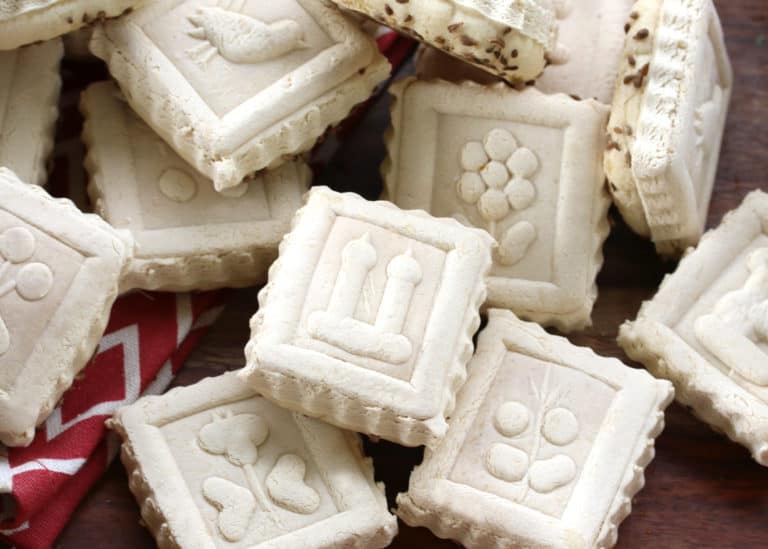
To put your molds and mold rolling pins to further use, be sure to try my traditional Speculoos cookies!
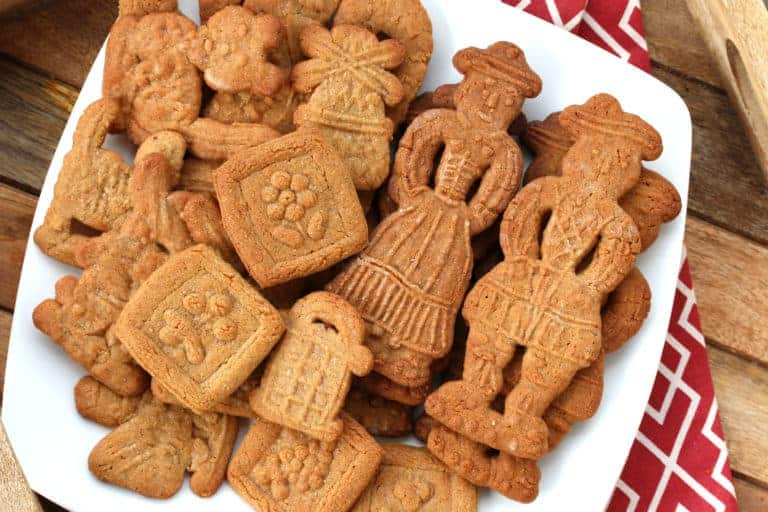
For more traditional German Christmas recipes try my:
- Stollen
- Zimtsterne
- Pfeffernüsse
- Lebkuchen
- Marzipan
- Bethmännchen
- Heidesand
- Magenbrot
- Kokosmakronen
- Marzipankartoffeln
- Haselnussmakronen
- Kinderpunsch
- Vanillekipferl
- Linserkekse
Save This Recipe
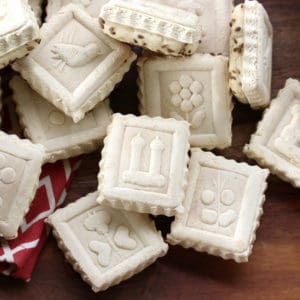
Authentic German Springerle Cookies
Equipment
Ingredients
- 3 large eggs , room temperature (the eggs must be large; if you are using medium add an additional egg)
- 3 cups powdered sugar (confectioner's sugar) (if using cups start with slightly less flour, 2-3 tablespoons, and add the rest as needed)
- 1 teaspoon quality pure vanilla extract (or 2 packets of vanilla sugar)
- 1/4 to 1/2 teaspoon quality 100% pure anise oil (not extract), how much you use depends on how strong of an anise flavor you want.
- 3 cups all-purpose flour (if measuring in cups start with slightly less flour and add the rest as needed if the dough is too soft/sticky)
- 1/4 teaspoon baker's ammonia *slightly less than 1/4 teaspoon (see blog post for explanation about baker's ammonia)
- 1/4 teaspoon salt
- zest of one lemon
- 2 tablespoons whole anise seeds
Instructions
- Place the eggs in a stand mixer with the whisk attachment in place. Beat the eggs until foamy. Add the powdered sugar, a little at a time along with the vanilla extract and anise oil.Once all the powdered sugar has been added continue to beat the mixture for 10 minutes. Yes, that's 10 full minutes, do not reduce the time. The batter needs to be very loose and airy. Note: Follow the instructions on your stand mixer to give your machine a rest after the suggested amount of time so as not to overwork your mixer.
- Combine the flour, baker's ammonia and salt in a bowl. Add HALF of the flour mixture to the wet mixture along with the lemon zest and beat it for a full 15 minutes, do not reduce the time (if the mixture is too dry for your whisk attachment, use the paddle attachment).Attach the paddle attachment, add the remaining flour and beat for another 5 minutes.The dough should be very soft but not wet and sticky. If the dough is too dry or stiff mix in a little more lightly beaten egg.Form the dough into a ball, flatten it to an inch-thick disk, wrap it in plastic wrap and refrigerate for at least an hour or overnight.
- The next day roll out the cold dough to about 1/3 inch thick (1 cm) on a floured work surface (if the dough chilled for several hours and is very firm, let it sit at room temperature until soft enough to work with). Use your molds or rolling pin to make the shapes and cut them out with sharp knife or pastry cutter. If you're using molds lightly dust them with flour to prevent the dough from sticking.Toast the whole anise seeds in a dry pan over medium-high heat until aromatic, being careful not to let them scorch. Place the anise seeds on a lined cookie sheet, spreading them out evenly.Lay the Springerle on top of the anise seeds on the baking sheet. Let them dry at room temperature for a full 24 hours, longer if you're in a place with high humidity. The outside of the Springerle should be dry.
- After the cookies have dried for at least 24 hours, lay a damp towel on the counter and gently press the Springerle down onto it to very lightly and evenly moisten the bottoms. Return the Springerle back to the cookie sheet.In an oven preheated to 300 degrees F with the rack positioned in the middle, bake the cookies for 20-30 minutes. Do not let the cookies turn golden, they're supposed to stay very pale, basically the same color as when you put them in the oven.
- The Springerle should have risen evenly to create their characteristic "feet" or platform underneath. Let the cookies cool off completely. They will become very hard as they cool. Springerle are traditionally stored in airtight containers with half of an apple next to them inside the container to create a little bit of moisture to gradually soften the cookies over time. Periodically change out the apple. Once the Springerle have slightly softened you can remove the apple and then continue storing them in the airtight container waiting for the flavor to develop.
Most Springerle bakers agree that waiting 3-4 weeks before eating them is best to allow the texture and flavor to develop.Enjoy these Springerle on their own or, as is tradition, enjoy them with a hot beverage and dip them.Makes about 34 Springerle depending on their size.
Notes
Originally published on The Daring Gourmet November 17, 2019



















I followed the recipe to a T. It came out dry and my new stand mixer was pretty hot. I ended up adding 1/2 beaten egg at the end so the mixer can spin without burning up. Left dough in plastic wrap overnight. Was very hard to roll out the next day. I’ve been making Springerle for years and this was my driest dough.
I made these exactly as written, and I am SO EXCITED to eat these in a few weeks! One caution – when drying the cookies, make sure they are dried in a well ventilated area. (Anise for dogs is like catnip to cats. My dog was on overload all morning because her crate was too close to where the cookies were drying.)
The Weight/Volume for flour and powdered sugar may be the cause of stiff, hard dough results like I experienced. Online sources are somewhat inconsistent but it seems 3c flour = 360g and 3c of powdered sugar = 375g. Add that to perhaps the “large” eggs bought at the U.S. grocery store may not be large in the sense of other country “large” standards (I am not sure what country this recipe is coming from but that could be a factor). I am going to try this again using gram weight, and I may add 1/2 beaten egg.
Made this springerle recipe twice because it’s soo good.. The first time I sifted and weighed everything just to be sure. The second time I weighed only the flour. Both times success and good yield! They had a slightly better texture in the first attempt. I highly recommend weighing flour, otherwise for me it would have been over by 1/2 cup!! I only wish my mom was still here to experience your helpful tips for success!! Also, I took a soft pastry brush and brushed flour off the small scrap pieces and refilled them. While the 4 miniatures didn’t lift as high the ywere very good! My mom made these every year apparently without bakers ammonia but I still loved them❤️ Thank you so much!
Thanks so much for the feedback, Betsy, I’m happy they were a success!
Hello,
Do you know if the brand Now for anise oil is safe for cooking? Also, I had no time to order baker’s ammonia; what is a good substitute?
Hi Denise, the only NOW anise product I’ve seen is for star anise, which is a different than regular/common anise. For the baker’s ammonia you can substitute the same amount of baking powder.
Fennel seed, for the whole spice but for the oil and extracts its called anise, it also depends on the country you live in
Hi Lauren, those are common misperceptions – anise seed is not the same as fennel seed and anise extract is extracted from anise seed. Likewise star anise and common anise (which this recipe calls for) are not the same thing either.
I’m sorry to say, that I loss 2 days and have no cookies. The Recipe was followed as written, the dough just crumbled, won’t roll until it got to almost room temperature. Could not reroll the left over dough, won’t stick together, was a total disaster. I do not recommend this recipe.
Pam, too bad – I weighted my ingredients and used ammonia Carbonate and they worked great! Weighing is important as flour can have different volumes based on water content.
This recipe is really great. The notes about the ingredients were particularly helpful in understanding how important using amonium bicarbonate and no butter.
Thank you, Dana, I’m happy they were a success!
I absolutely love this recipe! It’s my second year using it, and they come out perfect. I make two triple batches, and my Kitchen-Aid (probably barely) handles it. It does get a bit warm, but I give it a rest period between.
I wish I could share photos! The mold I’m using is a giant Santa, and came from Germany. A triple batch gets me 10 springerle; that’s how big it is. I let them dry for a week.
I’ve been making the traditional anise flavor, and an all lemon, substituting lemon oil for the anise.
So awesome, Lee, thank you so much for the feedback!
The lemon oil one sounds so good! Thanks for sharing!
You may wish to know that when the button is used to scale up ingredients on this online recipe, the grams do not, nor do the numbers of packets of vanilla sugar, the amt. in the note about baker’s ammonia, nor the amount of lemon zest.
I notice incongruities, that’s all.
I bought the anise oil you reccomended and put in only 1/4th tsp. I tasted a tiny bit of raw dough and it seems to be such a super strong anise/licorice flavor!!! Will that calm down after baking? My cookies are beautiful and drying out now to bake tomorrow,
Did you use bakers’ ammonia, and had you added it before tasting the dough? Then the dough would have tasted AWFUL. The ammonia is released during baking and dissipates, leaving no residual taste or smell – but the raw dough should not be eaten. Also, these cookies need to age for 3 – 4 weeks, during which time the flavor does change. I would not go by the taste of the raw dough – keep a record of how much anise oil you used, then evaluate the taste after the cookies have aged, and adjust the amount of oil in your next batch – a lot has to do with your personal preference, so just tailor the amount to what you like.
Taste better than my mom’s since I used the anise oil instead of extract. However do not use a whole 1/4 tsp. of the baker’s ammonia. Your recipe is correct, I just didn’t see not to use a quarter teaspoon until I’d added it to the flour. The “feet” on my cookies really expanded.
I will make them again next year. I also could have let them dry before baking even longer since I live in Florida.
Firstly, these cookies are amazing! Just like my mom and grandma made.
Just one issue I seem to have, I follow your recipe exactly but after the final mix I end up with a mixing bowl of dry granules! The dough dose not come together at all, so I’ve been adding a fourth egg at the end. After that everything works out fine.
I measure the flour and sugar by weight so I know I have not added too much.
Any ideas?
Hi Peter, did you use large eggs? Egg sizes can vary depending on what part of the world you’re in so I add the note about adding some extra liquid/egg if the mixture is too dry. Also, did you beat it for a full 10 minutes the first round and for a full 15 minutes the second round (beating for the full length of time both times is critical)?
Kimberly thanks for getting back with me so quickly, it turns out that it was the eggs, l get mine from a local farm and they are medium at best, it has been so long since I’ve gotten my eggs from the grocery I had forgotten.
Made a batch this morning with actual large eggs and it came out perfectly.
That’s great, Paul, I’m glad you were able to identify the culprit and even happier the Springerle were a success!
I’ve been told that the median weight of large eggs in Europe is 55 grams and for large eggs in the USA is 50 grams. The class I took on making Springerle emphasized the importance of being very precise with sugar & flour weight but that egg usage was kind of open ended.
These are amazing
I’ve been making these using a different recipe for 10 years…this year tried these and they came out with perfect “feet” crunch outside soft and chewy inside.
That’s fantastic, Katherin, thank you so much!
Thanks for sharing the history and recipe.
I made Springerle and they turned out great! One question: is there any recommended way to speed up their drying after they are cooked? I like them harder than they turned out just after baking, and don’t have 2-4 weeks to cure them before the holidays. I thought about using a dehydrator..
Hi Michele, I’m glad they were a success, thank you! They get pretty darn hard after a few days. If they’re not really hard it could be that they didn’t bake long enough. Beyond baking I’m not sure how to speed up the hardening process.
Hello — I wanted to try two variations on this recipe — something for a gluten-free friend and another version for a diabetic friend. Is there a way to make this as a gluten-free recipe? Could I use almond flour, for example, or is there a better alternate? I also wanted to make a version for a diabetic friend. Can I reduce the sugar content but would I increase the flour per se to compensate or it’s ok just to use less sugar? Thank you
Hi Janice, I have never tried either so I’m not sure how well it would work. Perhaps one of our readers has tried it and can chime in.
I have used Pamela’s gluten free baking and pancake mix to make them and they were delicious. They didn’t make it to the three week curing time ( because we ate them all) but it was a lovely gf alternative.
Janice:
I’m not sure about the diabetic part, but my kids have celiac disease so we’ve been baking gluten-free for 12 years now. I recommend Bob’s Red Mill 1:1 gluten-free flour. You don’t need to add anything else. They won’t rise as much as the regular version, but the taste and texture are close.
Good luck!